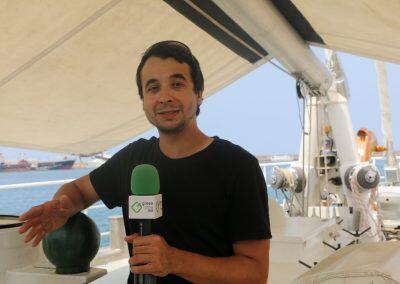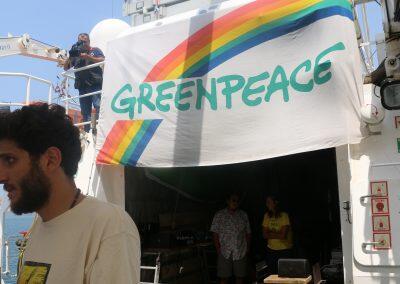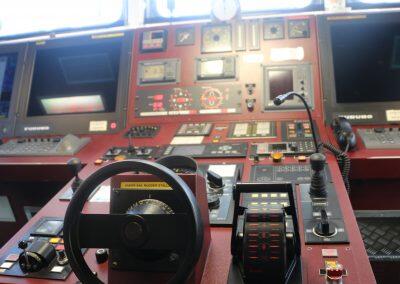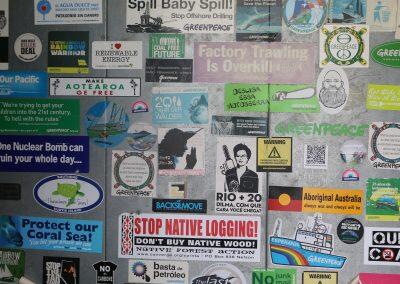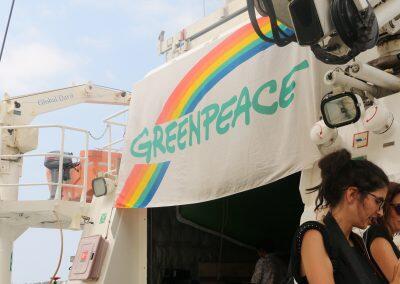One of the most important things the tour will collect is messages of support from the countries it is visiting, regarding the dramatic increase of solar energy capacity in the Mediterranean. It will deliver them to the leaders at the COP22 climate negotiations.
A glimpse of light
A glimpse of light will be happening out of this campaign in Lebanon. It already started taking place. In South Lebanon, 12 young Palestinians, Syrians and Lebanese people from the area, trained by Greenpeace, will build solar panels on a Women’s Cooperative center.
This community-driven initiative can serve as an example of how accessible and empowering renewable energy can be for everyone in the region. Each contribution to this project is an additional step towards a true energy independency for this cooperative, the hard-working women and their community.
In an interview with “greenarea.info”, Daad Ismail, head of the cooperative told us that solar energy has made work a lot more easier, especially that “the electricity in Lebanon is unpredictable, and the food we are making would be ruined this way”.
Apart from the tasty “Ka’ak” she is doing with other women, Da’ad told us that she learned more about the benefits of solar energy, and that she now knows how it can facilitate her life, and protect the environment at the same time. Less money is needed for the work to function with solar energy.
Here is the yummy Kaak each of us took home from the press conference. I tried it with Labneh. I will be visiting the women very soon to get more of this Eco-friendly tasty food.
Zeina El Hajj, Greenpeace Mediterranean Executive director, said: “As a symbol of peace and renewable energy, the Warrior’s bow can cut through the imposed myth of a region suffering from violence and conflict and tell a new story; a story about local heroes striving to make their lives and their communities sustainable and safe under an abundant resource: the sun.”
Peter Willcox, Captain of the Rainbow Warrior, said: “It is time for people here to embrace what shines in the sky 300 days a year, not what’s tapped from the ground,” adding that “It is not just about building a sustainable renewable energy future for the region, it’s about tipping the balance away from fossil fuels for the health of the planet while self-empowering local communities.”
At each of its stops, the Rainbow Warrior will be open to the public, where people will get to meet the crew while exploring the ship and celebrating the region’s abundance, its culture, food, music, people and the sun.
16 years and counting…
We also met Penny Gardener, one of the crew members whose role is a boson on the ship, meaning that she takes care of the outside of the ship, helping with the sails, and watching out at night. She has five other people in her team. Petty has been with Greenpeace for 16 years. They passed so quickly, she said happily; It is obvious that she loves what she’s doing.
Gardener describes other crew members as “highly educated and dedicated”, since they all take part in protests and actions on the ship.
Nazareth, from Italy, on the other hand, explained some details about the ship from the inside, joking that the steering wheel today “is not like the one we see in the movies”, meaning that it is all updated with the latest technologies. For example, screens show everything happening in the engine room.
Significance of “Rainbow Warrior’s” presence in Lebanon
Peter Wilcox, Captain of the ship, said in an interview with “greenarea.info” that “the significance of being here is to talk about solar energy, especially that the Mediterranean is rich with solar energy”. He warned about the effects of burning more fossil fuels, which of course leads to global warming.
We will end the article about Rainbow Warrior in Beirut with Gardener’s words on using solar energy in Lebanon, but we will also give an overview of rainbow warrior below:
Gardener told us that we have a wonderful opportunity to change our energy systems, and to use the sun. This will solve our energy crisis, she said, since we have lots of sun.
“There is so much hope for the electricity problem in Lebanon, because you have so much sun.”, the dedicated Greenpeace member added.
The Bombing of the Rainbow Warrior
Greenpeace International mentioned on its website the following information about the bombing of the rainbow warrior:
In 1985, French secret service agents planted two bombs and sank our ship the Rainbow Warrior. One crew member was killed. It was an instance when a government chose to respond to peaceful protest with deadly force. But peaceful protest has prevailed.
10 July 1985. The Greenpeace ship the Rainbow Warrior is moored in Auckland, New Zealand – ready to confront French nuclear testing in the Moruroa Atoll.
It’s close to midnight. The captain, Pete Willcox, and many other crew members are already asleep. A few others, including the photographer Fernando Pereira, are still chatting around the mess-room table, sharing between them the last two bottles of beer.
Suddenly, the lights go out. There’s the sharp crack of breaking glass. Then, a sudden roar of water. The crew’s first thought: We’ve been hit, possibly by a tug.
Then, there’s a second explosion.
Rainbow Warrior in Auckland Harbour after bombing by French secret service agents. (Annual review 1993-1994 page 2) Accession #: 0.85.072.001.01
Those already on deck scramble up the ladder or leap to safety on the wharf. Within minutes, they see the ship’s steel masts tilt towards them…
The tragic death of a crew member
“I stood there looking at the boat with all of these bubbles coming out of it,” captain Pete Willcox would later recall. “That’s when Davey [Edwards] said Fernando is down there. I remember arguing with him, saying no, Fernando has gone to town, that’s what he always did. No he said. Fernando is down there.”
The Portugal-born Greenpeace photographer Fernando Pereira had joined the crew of the Rainbow Warrior to document the French nuclear testing and bring his photographs to the world.
He was caught in a rush of water that night, and drowned. He had just celebrated his 35th birthday.
A state-sanctioned bombing – shrewdly planned and executed
The Rainbow Warrior wasn’t hit by a tug, of course. In an attempt to “neutralise” the ship ahead of its planned protest, French secret service agents in diving gear had attached two packets of plastic-wrapped explosives to it, one by the propeller, one to the outer wall of the engine room.
Initially, the French government denied all knowledge of the operation, but it became soon obvious that they were involved. Eventually, prime minister Laurent Fabius appeared on television and told a shocked public: “Agents of the DGSE (Secret Service) sank this boat. They acted on orders.”
First they denied, then they disappeared
Only two agents ever stood trial. Dominique Prieur and Alain Mafart, who had posed as Swiss tourists, pleaded guilty to charges of manslaughter and wilful damage, attracting sentences of 10 and 7 years. A UN negotiated settlement meant that they were transferred to Hao atoll, a French military base in French Polynesia.
They were both released within less than two years.
The spy who infiltrated the Greenpeace New Zealand office ahead of the bombing, Christine Cabon, evaded arrest in Israel. She hasn’t been seen since. The whereabouts of the combat frogman with the alias Jean-Michel Berthelot – one of the two divers believed to have planted the bombs – are unknown.
Most of those involved in what happened that night in an Auckland harbour have simply disappeared.
You can’t sink a Rainbow
The Rainbow Warrior was named after a North American Cree Indian prophecy: “When the world is sick and dying, the people will rise up like Warriors of the Rainbow…”
On its bow she proudly carried a dove of peace carrying an olive branch – never leaving any doubt about her non-violent mission. All around her hull, there were the striking colours of the rainbow.
After the bombing, the ship was given a resting place at Matauri Bay, in New Zealand’s Cavalli Islands, where it has become a living reef, attracting marine life and recreational divers.
Greenpeace replaced her with a new vessel, and for 22 years, the second Rainbow Warrior has campaigned for a green and peaceful future. In 2011 the new Rainbow Warrior, the world’s first purpose-built environmental campaigning ship, readied herself to carry on the original Rainbow Warrior’s spirit. It’s a spirit that will always live on.





